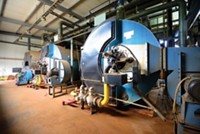Advertisement
Grab your lab coat. Let's get started
Welcome!
Welcome!
Create an account below to get 6 C&EN articles per month, receive newsletters and more - all free.
It seems this is your first time logging in online. Please enter the following information to continue.
As an ACS member you automatically get access to this site. All we need is few more details to create your reading experience.
Not you? Sign in with a different account.
Not you? Sign in with a different account.
ERROR 1
ERROR 1
ERROR 2
ERROR 2
ERROR 2
ERROR 2
ERROR 2
Password and Confirm password must match.
If you have an ACS member number, please enter it here so we can link this account to your membership. (optional)
ERROR 2
ACS values your privacy. By submitting your information, you are gaining access to C&EN and subscribing to our weekly newsletter. We use the information you provide to make your reading experience better, and we will never sell your data to third party members.
Environment
Setting Limits On EPA Authority
Greenhouse Gases: Supreme Court strikes down part of agency’s CO2 rule for industrial facilities
by Glenn Hess
June 24, 2014
A divided Supreme Court on Monday set limits on the Environmental Protection Agency’s ability to regulate emissions of carbon dioxide and other greenhouse gases from power plants, chemical manufacturing facilities, and petroleum refineries.
The decision in Utility Air Regulatory Group v. EPA addresses a part of the Clean Air Act that requires companies to obtain permits when they build a new plant or modify an existing facility in ways that will boost air pollution output.
In a 5-4 ruling, the high court’s conservative majority says EPA cannot require industrial sources of pollution to obtain Clean Air Act permits strictly on the basis of their potential greenhouse gas emissions.
But the situation is different if permits are also needed because the new or modified facility will emit other pollutants, such as nitrogen oxides or sulfur dioxide, the court says. Under this condition, the agency can require installation of the “best available” pollution-control technology to limit all types of regulated emissions, including greenhouse gases.
“Requiring permits for sources based solely on their emissions of greenhouse gases … would be incompatible with the substance of Congress’s regulatory scheme,” Justice Antonin Scalia writes in the majority’s opinion.
The chemical industry welcomes the court’s decision. “We are glad the court corrected EPA’s misreading of the Clean Air Act,” says Calvin M. Dooley, chief executive officer of the American Chemistry Council, an industry trade group. The ruling, he says, preserves EPA’s ability to regulate greenhouse gases from motor vehicles but will “prevent the agency from sweeping in thousands of small businesses and factories into the permitting program.”
EPA, meanwhile, declares victory in the case, calling it ‘‘a win for our efforts to reduce carbon pollution” because it allows EPA, states, and other regulatory agencies to continue to impose CO2 limits on the largest pollution sources.
Environmental groups also praise the decision. It “builds on the court’s prior decisions upholding the most important Clean Air Act authority in the fight against global warming,” says David Doniger, director of the Climate & Clean Air Program at the Natural Resources Defense Council.
The Supreme Court’s ruling is unlikely to affect EPA’s recent proposal to establish greenhouse gas emissions standards for new and existing power plants (C&EN June 2, 2014, page 8). The agency is exercising its authority under a different part of the Clean Air Act to issue those regulations.




Join the conversation
Contact the reporter
Submit a Letter to the Editor for publication
Engage with us on Twitter